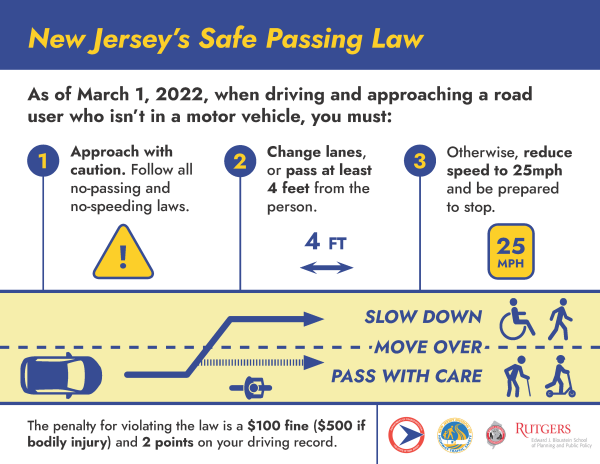
The New Jersey Safe Passing Law came into effect on March 1, 2022, and aims to protect “vulnerable road users” (road users not protected inside vehicles), including cyclists, pedestrians, scooters, and people in wheelchairs, from near misses, injuries, and deaths that occur when motorists pass these road users unsafely. Many people have expressed confusion about the NJ Safe Passing Law that we recently promoted again on social media.
Some common questions include: Can I cross the double line? Why can’t cyclists use the shoulder? Why are cyclists and pedestrians on the road? And what should I do if I can’t pass a cyclist with at least 4 feet between us due to oncoming traffic? Here are some answers to these questions.
- Also known as “Oscar’s Law,” the bill was introduced to protect people like Oscar, who could not drive a car and was riding his electric bicycle everywhere when a tractor-trailer fatally struck him.
- 2021 was the deadliest year for NJ bicyclists and pedestrians in 30 years, highlighting the need to do more to protect everyone on the road.
- According to the law, Drivers must follow all current no-passing, no-speeding rules AND move over a lane IF there’s one to move into. So no, you do not have to pass when center lines are both solid, but
- If 4 feet is not possible on a section of road, drivers must slow to 25mph and be prepared to stop until they can pass safely without endangering those sharing the road.
- On a single-lane road, drivers must allow at least a 4-foot safety zone when they pass.
- If you see a pedestrian or a bicyclist on the shoulder or riding in a painted bike lane, leave 4 feet between you and the person sharing the road, not the painted line.
- Cyclists are legally allowed to take the whole lane and can legally ride two abreast as far to the rights as “practicable.”
- When sidewalks are unavailable, pedestrians can walk on the road, facing traffic.
Other people wondered, “Why do cyclists have the right to use roads? They are not paying for the roads.” Here’s what we all do; regardless of car ownership or driving habits, road funding primarily comes from taxes that we all contribute to through sales and income taxes. The gas tax only covers a small portion of road infrastructure costs. Cyclists who do not own a car pay more for the road system than the infrastructure dedicated to biking alone. Here is more about that.
Most cyclists are also car owners but choose to ride their bikes for various reasons, including that most of their trips are under five miles and easier to bike or are looking for a more sustainable way to travel. Other people choose to walk or bike for the health benefit of adding more physical activity to their day. For others, one less car on the road means less traffic and cleaner air. Other people have no choice, whether due to income, ability, or age.
Have you ever thought about what it would be like to be unable to drive your car suddenly? You might have to walk or bike to run errands or visit nearby stores, but it can be challenging. Or imagine having children trying to walk and bike to a nearby park and worrying about them getting into a crash.
A little patience and understanding for each other will help us create less congested, safer roads for everyone. Remember what we learned when we were little, sharing is caring. If you have a question we have not answered here, please let us know, and we’ll be happy to get in touch.
Sources:
http://njbikeped.org/nj-safe-passing-law/
https://pub.njleg.state.nj.us/Bills/2020/PL21/194_.PDF
https://njbwc.org/safepass4nj/details-of-the-law/?mc_cid=515a2c9592&mc_eid=0676669a92
